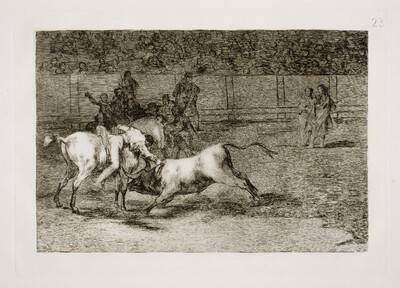- Cronología
- Ca. 1814 - 1816
- Ubicación
- The Prado National Museum. Madrid, Madrid, Spain
- Dimensiones
- 186 x 318 mm
- Técnica y soporte
- Reconocimiento de la autoría de Goya
- Documented work
- Titular
- El Prado National Museum
- Ficha: realización/revisión
- 02 Oct 2021 / 22 Jun 2023
- Inventario
- (D4310)
11 (in pencil, lower left corner)
See How the ancient Spaniards hunted bulls on horseback in the countryside.
This preparatory drawing passed by inheritance in 1828 to Javier Goya, the painter's son, and in 1854 to Mariano Goya y Goicoechea, the artist's grandson. It was subsequently owned by Valentín Carderera (ca. 1861) and Mariano Carderera (1880). In 1886 it was acquired from Mariano Carderera, along with many other drawings by Goya, including almost all the preparatory studies for the Bullfight, by the Directorate General of Public Instruction, and was assigned to the Prado Museum, where it entered on 12 November 1886.
See How the ancient Spaniards hunted bulls on horseback in the countryside.
Preparatory drawing of the print Mariano Ceballos, alias " The Indian ", kills the bull from his horse. When the scene was transferred to engraving, it was slightly modified, especially the background, while the front part remained almost unchanged in terms of figures and composition.
The front or main group, consisting of Mariano Ceballos, his horse and the bull, is notable for its lighting, as the rest of the scene is covered by a kind of glaze in sanguine. Comparing the drawing with the engraving, we can see how the aforementioned effect of darkness or shadow achieved with the sanguine was replicated by Goya in the print using aquatint. In this main group, the good work done with the horse and the bull stands out, as the anatomical study of both animals is of very high quality, as well as the bullfighter's posture, practically on top of the bull, in a very successful unstable position, in order to be able to thrust the sword into him.
Inside the bullring itself, in the background, groups of people can be seen, some of whom remain in the same place in the print, but with different numbers of members.
The drawing was pasted onto a second piece of laid paper belonging to a French army record book in Spain.
The paper retains creases from being passed through the press
-
Goya. Drawings, Etchings and LithographsGoya. DrawingsLondon1954from June 12th to July 25th 1954pp. 11-12, cat. 68
-
Goya (1746-1828). Peintures-Dessins-GravuresCentre Cultural du MaraisParís1979consultant editors Jacqueline et Maurice Guillardcat. 75
-
Goya: Zeichnungen und DruckgraphikStädtische Galerie im Städelschen KunstintitutFrankfurt1981from February 13th to April 5th 1981
-
Goya: toros y torerosEspace Van GoghArles1990displayed also at Academia de Bellas Artes de San Fernando, Madrid, consultant editor Pierre Gassier.cat. 26
-
cat. 77
-
Madrid2002
-
2005cat. 2
-
Madrid2007
-
1946pp. 177-216, espec. p. 201
-
MadridMuseo del Prado1954n.176
-
1961pp. 120-127
-
ParísLe Club Français du Livre1963p. 109
-
Vie et ouvre de Francisco de GoyaParísOffice du livre1970p. 279, cat. 1197
-
Barcelona1974p. 16
-
Dibujos de Goya, 2 volsBarcelonaNoguer1975pp. 380-381, cat. 265
-
MadridSilex1980pp. 152-153, cat. 51
-
MadridMuseo Nacional del Prado2001pp. 80-81

